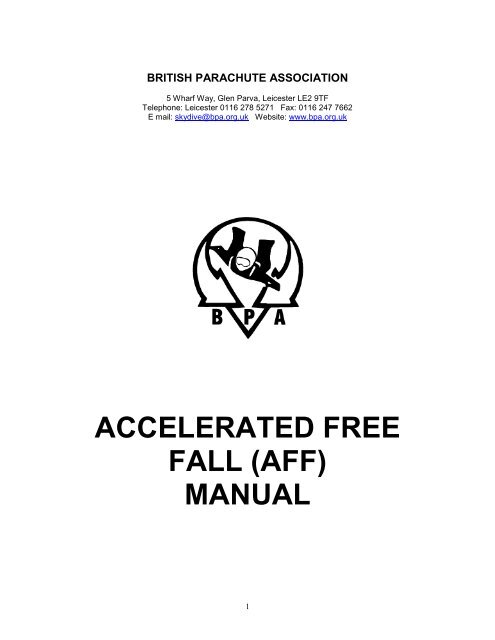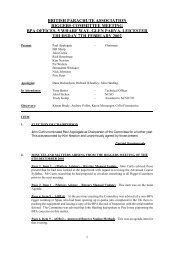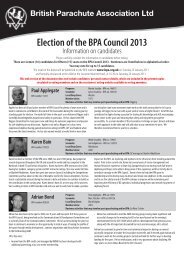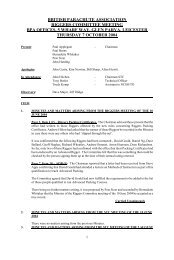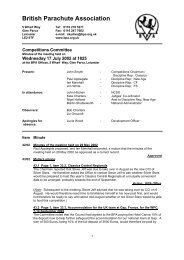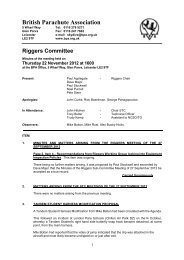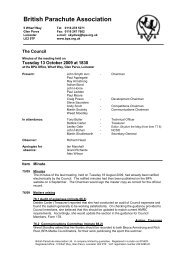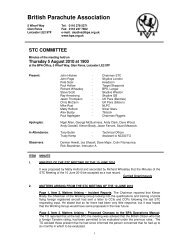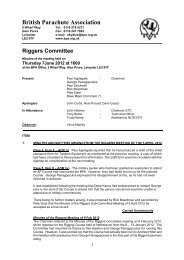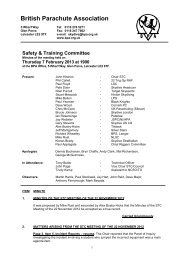accelerated free fall (aff) manual - British Parachute Association
accelerated free fall (aff) manual - British Parachute Association
accelerated free fall (aff) manual - British Parachute Association
You also want an ePaper? Increase the reach of your titles
YUMPU automatically turns print PDFs into web optimized ePapers that Google loves.
BRITISH PARACHUTE ASSOCIATION<br />
5 Wharf Way, Glen Parva, Leicester LE2 9TF<br />
Telephone: Leicester 0116 278 5271 Fax: 0116 247 7662<br />
E mail: skydive@bpa.org.uk Website: www.bpa.org.uk<br />
ACCELERATED FREE<br />
FALL (AFF)<br />
MANUAL<br />
1
The Accelerated Free Fall (AFF) Programme originated in the late 70s early 80s in America, and was<br />
developed as an alternative training programme to the conventional static line/short delay system, AFF<br />
follows a different route to the same end. In essence an alternative method of achieving Category 8, from<br />
jump number 1.<br />
The aim of the BPA’s AFF Programme is to ensure that the student has the basic survival and control skills<br />
needed to skydive safely and confidently on their own. This must be the overriding consideration when<br />
instructors are using the programme.<br />
Requirements for AFF can be found in the BPA’s Operations Manual. Ensure that you are aware of current<br />
regulations.<br />
LEVEL 1 – GROUND TRAINING (A GUIDELINE)<br />
Personnel required: Two AFF Instructors as required.<br />
1. Concept of the Accelerated Free Fall programme.<br />
This programme is called “Accelerated Free Fall” because the learning process can be quite a lot faster than<br />
with the RAPS static line progression programme. Although both systems can get the student to Category<br />
8 in the same minimum number of jumps, the personal tuition provided on the AFF Programme usually<br />
ensures that the average student will qualify in a shorter time frame. The programme has been carefully and<br />
systematically developed. It utilises the skills, techniques, and equipment that have evolved in skydiving to<br />
give the student an intensive learning experience. The <strong>British</strong> <strong>Parachute</strong> <strong>Association</strong> approves this training<br />
method for use at BPA Affiliated Clubs that are equipped and st<strong>aff</strong>ed adequately to run the AFF<br />
Programme.<br />
The lessons outlined below contain the topics that should be covered in the initial training. The exact order<br />
may vary from DZ to DZ.<br />
a. RAPS Method:<br />
(i)<br />
(ii)<br />
(iii)<br />
The Traditional/RAPS method of learning to skydive starts with a static line parachute<br />
jump. This jump provides only the opportunity to exit the aircraft and assume the proper<br />
body position.<br />
The student may then move on to practice ripcord pulls, before being permitted to go<br />
onto <strong>free</strong> <strong>fall</strong> after a minimum of five jumps.<br />
Further progression is made by successfully completing the exit, assuming a proper body<br />
position and executing the actual ripcord pull within five seconds, then ten seconds.<br />
During these fleeting exposures to <strong>free</strong> <strong>fall</strong> the student also may have to deal with a<br />
phenomenon known as ‘sensory overload’. It is the rush of stimuli to the senses that<br />
overloads the system and distorts a person’s perceptions.<br />
(iv) The student then learns how to make turns, back loops and track while <strong>fall</strong>ing by him /<br />
herself for periods of around 30 to 40 seconds. Throughout this entire phase the student<br />
is usually observed from the ground or air, without any in-air coaching.<br />
2
. Accelerated Free Fall Method:<br />
(i)<br />
(ii)<br />
(iii)<br />
(iv)<br />
N.B.<br />
In the Accelerated Free Fall method a student is shown stability and practices it with<br />
direct assistance within a larger time frame. He or she may still experiences sensory<br />
overload, but has the opportunity to overcome it. It usually takes about five seconds.<br />
Then practice pulls and the actual ripcord pull are made and direct assistance is provided<br />
when necessary. More learning takes place faster, with fewer jumps and with less<br />
exposure to opening and landing problems.<br />
The student progresses through eight levels at his or her own learning pace.<br />
The skills required for exiting and <strong>fall</strong>ing, with stability and control, are practiced and<br />
developed through intensive ground training and direct in air supervision.<br />
As the student gains awareness in <strong>free</strong><strong>fall</strong>, the complexity of the exercises increases. The<br />
student will learn how to control turns, backloops and tracking during the 8 levels.<br />
Throughout this <strong>manual</strong> the method of deployment refers to the ripcord. Some<br />
clubs/organisations use an ‘accepted’ throwaway deployment system. Therefore,<br />
deployment sequences/methods will differ.<br />
2. Orientation.<br />
Note: Level 1 is an introduction to the Sport of Skydiving and may be the person’s first jump.<br />
a. Documentation – BPA Membership and all relevant documentation.<br />
b. Airfield discipline and local regulations.<br />
c. Outline training syllabus.<br />
d. Show any video or photos, etc on AFF.<br />
e. Show aerial photos on Airfield and visit airfield.<br />
N.B.<br />
BPA Provisional membership is valid for AFF Level 1only, following which the student must<br />
convert to full membership, unless he/she has taken out Temporary (one month) or Full<br />
membership.<br />
3. Equipment Familiarisation<br />
a. Show rig and demonstrate features – 3 ring, ripcord etc.<br />
b. Show accessory equipment – gloves, suit, alti, helmet, etc.<br />
c. Put rig on – show students how to do a “hands on” safety check.<br />
d. Deploy canopy and demonstrate ‘nuisance factors’.<br />
e. Reserve deployment – explain / show differences.<br />
N.B.<br />
Spend time on how to operate, not on how to design, build or maintain equipment.<br />
4. Stability and Practice Pulls.<br />
a. Explain the theory of stability – use model.<br />
b. Explain the neutral position – stress the necessity for arching on exit, then maintaining neutral<br />
position during jump.<br />
c. Demonstrate practice pull – allow student to practice.<br />
d. Put rig on – student practices stable position and practice pulls and performs an “Actual Pull” on<br />
the equipment he/she will be using.<br />
3
5. Aircraft Familiarisation.<br />
Note:<br />
Exit procedures, seating position and emergency procedures will vary according to the aircraft<br />
type. However, it is important that during exit at least one Instructor maintains positive control<br />
with a HARNESS GRIP on the student and assist as necessary.<br />
a. Explain the A/C type and seating positions.<br />
b. Climb to altitude procedure.<br />
(i) Protect Handles.<br />
(ii) Instructors are in control.<br />
(iii) Mental rehearsals on climb to altitude, using key altitudes as a reminder.<br />
(iv) Student verbally relates jump to instructors.<br />
(v) Final equipment check.<br />
(vi) Climb-out procedures.<br />
(vii) Hotel check (check in – check out).<br />
6. Aircraft Emergencies.<br />
Note:<br />
The Instructors are in control, Student listens to them for instructions.<br />
Emergency<br />
Forced Landing<br />
Low Altitude (Below planned opening height)<br />
High Altitude Exit (Above planned opening height)<br />
Premature Deployment<br />
Action<br />
Brace up – Exit away from prop once<br />
aircraft has stopped moving.<br />
Solo exit, or exit with 1 or both Instructors<br />
and pull immediately.<br />
Normal AFF launch, continue with the jump<br />
as normal.<br />
Smother, or immediately follow canopy out<br />
of door.<br />
N.B.<br />
Mention the need to switch off AAD (if practicable) if descent in Aircraft is necessary.<br />
7. Level One (Dirt Dives Including “IN AIR EMERGENCIES”)<br />
a. Explain and Dirt Dive level one jump. Practice until perfect.<br />
b. Cover “In air emergencies”.<br />
(i) Exit funnels – student arches.<br />
(ii) Loss of one instructor – student takes signals from another.<br />
(iii) Loss of both instructors (alone in <strong>free</strong> <strong>fall</strong>) – Arch, Reach, student pulls immediately.<br />
8. Canopy Opening and Control<br />
As an aid, use photographs and/or video.<br />
a) Explain Flight Characteristics of Main and Reserve <strong>Parachute</strong><br />
b) Explain Wind Drift Determination.<br />
c) Flight drills. (Use suspended harness at some stage)<br />
d) Check canopy<br />
e) Control Checks (nuisance factors)<br />
f) All round observation (check airspace / locate PLA)<br />
g) Clear Hazards<br />
h) Canopy exercises<br />
i) Left and right 360 o turns<br />
4
j) Practice flare<br />
k) Assess Drift<br />
l) Landing Pattern<br />
N.B (1). Stress importance of landing with canopy in level flight, preferably into wind.<br />
N.B (2). Mention Ground to Parachutist Radio and Canopy Landing Aids.<br />
NB (3). Bear in mind that at some stage during progression jumps, or during consolidation jumps, the<br />
student will need to be introduced to the Canopy Handling (CH) Manual, as he/she will need to<br />
obtain CH1 prior to being signed off for an FAI ‘A’ Certificate.<br />
9. Canopy Malfunctions and Emergency Procedures.<br />
Inform the student that malfunctions are a real possibility, although rare. The actual malfunction procedure<br />
you teach will depend on your CCI. However, in the event of a malfunction, or being unable to deploy<br />
main, initiate Emergency Procedure (IMMEDIATELY) in accordance with club rules.<br />
a) Mention floating handle and hard pull, (or problems with throwaway pilot chute, if used).<br />
b) Accidental reserve deployment under main.<br />
c) Entanglement Procedures – stress checking canopy<br />
d) Mention control checks<br />
e) Stress importance of cutting away at a SAFE altitude<br />
PRACTICE EMERGENCY DRILLS IN SUSPENDED HARNESS UNTIL SMOOTH AND EXACT.<br />
10. Landings.<br />
Flat and level.<br />
Into wind flared landing practice, (Do not flare too quickly).<br />
Standard PLF Training (Good Landing Position)<br />
a) Prepare to land. Stand up and collapse canopy<br />
b) Practice on the ground and from platforms or fan trainers.<br />
c) Flaring too high / too low<br />
11. Abnormal Landings – Teach how to avoid, (High up)<br />
a) WATER – teach whatever is appropriate to your Club. Remember AFF Rigs use a<br />
Reserve static line (RSL).<br />
b) ELECTRICITY CABLES.<br />
c) BUILDINGS<br />
d) TREES<br />
e) ROADS AND RUNWAYS<br />
Most abnormal / hazardous landings can be avoided if student “steers away” beforehand. Stress a<br />
crosswind or downwind landing is preferable to landing on a hazardous object, and avoid fixating on the<br />
hazard (“look away”).<br />
On completion of ground training the student must take a written exam, as an aid to determining his/her<br />
comprehension of the training and to ensure that nothing has been missed by the instructor. This exam must<br />
fully reflect the course content and procedures taught by the AFF School that the student will be jumping<br />
with. Students must undergo a minimum period of 6 hours of actual ground training, not including prejump<br />
revision / dirt-dive.<br />
5
LEVEL 1 - FREE ARM (BPA Ops Manual, Section 2, para 5.1)<br />
Personnel required: Two AFF Instructors<br />
Learning Objectives for each level – Standard and Emergency<br />
Note: Emergency procedures and all learning objectives should be reviewed in accordance with the BPA<br />
Operations Manual, Section 5 para 3, and where applicable, before each jump.<br />
a. Concept<br />
b. Equipment Familiarisation<br />
c. Aircraft Familiarisation<br />
d. Exit/climb out procedure<br />
e. Exit and jump<br />
f. Canopy opening and control<br />
g. Landing procedure<br />
1. Learning Objectives<br />
a. Exposure to continuous <strong>free</strong> <strong>fall</strong><br />
b. Heading awareness<br />
c. Focused awareness and attention<br />
d. Co-ordinated body movements from <strong>free</strong> arm to practice pulls<br />
e. Altitude awareness<br />
f. Actual ripcord pull by 5,000 ft.<br />
2. Procedures – before jump.<br />
a. Question and answer session with student – general<br />
b. Using DZ photos, brief for expected exit and opening points<br />
3. Rehearsal.<br />
a. Emphasise arch – pelvis pushed forward, head back, arms and legs bent, point toes.<br />
b. Student and both instructors walk through the entire jump until smooth and exact<br />
c. Full dress, dirt dive<br />
d. Student may actually pull main ripcord again<br />
e. Do a complete equipment check prior to boarding the aircraft<br />
f. Climb to altitude procedure and last equipment check<br />
4. Jump Sequence (A Guideline)<br />
a. Student demonstrates awareness – circle of awareness (HASP – Heading, Altitude, Secondary,<br />
Primary) and proper body position<br />
b. Instructors agree to release arms<br />
Student does practice pulls – Instructors may assist as necessary (another circle of awareness may<br />
be done here) and <strong>free</strong> time<br />
c. Instructors may re-grip arms by 5,500 ft<br />
d. Student demonstrates awareness – ‘clocks on altimeter’<br />
e. Student signals “5-5” and initiates pull.<br />
Primary ensures pull by 5,000ft and an instructor monitors pilot chute and canopy deployment<br />
6
If possible land with or near the student, providing orientation and guidance. Have the student<br />
clear ears after opening and during the descent.<br />
5. Debriefing.<br />
a. Act it out – Students version first, Instructors second, video (if used) third.<br />
b. Give student additional training to correct weak areas and preview the next jump. Be<br />
constructive.<br />
c. Fill out students' log and DZ records – indicate level for next jump.<br />
7
LEVEL 2 – FREE ARM – PLUS (BPA Ops Manual, Section 2, para 5.2)<br />
Personnel required: Two AFF Instructors<br />
1. Learning Objectives.<br />
a. Maximum <strong>free</strong> arm time<br />
b. Practice pulls as required<br />
c. Heading awareness<br />
d. Relaxed body position throughout the entire <strong>free</strong> <strong>fall</strong><br />
e. Solo pull by 5,000’<br />
2. Procedures.<br />
a. Review previous jump and discuss problems<br />
b. Refresh previous training and give additional training with emphasis on learning objectives<br />
c. Using DZ photo, discuss where to climb out, exit point, opening point, landing point<br />
3. Rehearsal.<br />
a. Informal – with emphasis on relaxed control, relaxed position, heading awareness, observation of<br />
canopy deployment.<br />
b. Dirt Dive, standing/horizontal. Full Dress – Dirt dives, talk through, walk through, then silent dirt<br />
dives.<br />
c. Do a complete equipment check prior to boarding the aircraft. Climb to altitude procedure and last<br />
equipment check.<br />
4. Jump Sequence (A Guideline)<br />
a. Student demonstrates awareness and proper body position.<br />
b. Instructors agree to release arms.<br />
c. Student makes circle of awareness, followed by practice pull.<br />
d. Instructors, if possible, hold harness grip with no tension, secondary can release if appropriate.<br />
e. Student initiates pre-pull signal.<br />
f. By 5,000’ student pulls on own altitude awareness.<br />
Land with or near student if possible.<br />
5. Debriefing – standard<br />
8
LEVEL 3 – RELEASE DIVE (BPA Ops. Manual, Section 2, para 5.3)<br />
Personnel required: Two AFF Instructors<br />
1. Learning Objectives<br />
a. Practice pulls (optional)<br />
b. Heading maintenance<br />
c. “Hover Control” by student. Give the student as much opportunity as possible to <strong>fall</strong> unassisted.<br />
d. Solo pull by 4,500 ft.<br />
2. Procedures<br />
a. Review and discussion.<br />
b. Refresher and new training – alter students' in-air emergency procedures to accommodate<br />
intentional release. Mention level 2.<br />
3. Rehearsal<br />
a. Informal – with emphasis on leg awareness, heading and “hover”. Student practices corrective<br />
moves to maintain heading and horizontal position.<br />
b. Student pulls on own altitude awareness primarily by 4,500 ft .<br />
c. Full dress dirt dive emphasising body control.<br />
d. Do a complete equipment check prior to boarding the aircraft.<br />
e. Climb to altitude procedure and last equipment check.<br />
4. Jump Sequence (A Guideline)<br />
a. Student demonstrates awareness and proper body position.<br />
b. Instructors agree to release arms.<br />
Instructor may require Student to do one practice pull (determination based on Students history<br />
and interval since last jump), and/or click heels together.<br />
c. Instructors agree to release.<br />
d. Instructor 2 releases on signal from Instructor 1, and stays to side of student.<br />
Instructor 1 releases grip and stays in position ready to immediately re-grip or correct body<br />
position.<br />
e. Student to caries out pre-pull signal to show altitude awareness and pulls by 4,500 ft.<br />
f. Instructors must be alert to assist in the event of student spin or loss of stability.<br />
5. Debriefing - standard.<br />
9
LEVEL 4 – START ND STOP TURNS (BPA Ops <strong>manual</strong>, Section 2, para 5.4)<br />
Personnel required: One AFF Instructor<br />
1. Learning Objectives<br />
a. Start and stop turns<br />
b. Wave Off (may be introduced, if not already)<br />
c. Solo Pull by 4,000ft on own altitude awareness<br />
2. Procedures<br />
a. Review and discussion.<br />
b. Refresher and new training.<br />
3. Rehearsal<br />
a. Informal – exit may be changed, e.g. climb-out, if so encouraged to be unassisted, but<br />
b. Instructor maintains control.<br />
c. Explain relative wind and its relation to the ground.<br />
d. Explain use of arms to turn.<br />
e. If introducing wave-off to pull procedure (start at about 500ft above pull height). Pull by 4,000 ft<br />
or on own altitude awareness.<br />
f. Full dress rehearsal; go through entire dive.<br />
g. Equipment check prior to boarding the aircraft.<br />
h. Climb to altitude procedure and last equipment check.<br />
4. Jump sequence (A Guideline).<br />
a. Student demonstrates awareness and proper body position,<br />
b. Instructor releases student.<br />
c. Student performs turn, checks altimeter.<br />
d. Repeat for turn, observing student altitude awareness. No more turns performed below 6,000 ft.<br />
Student, if in good position, can <strong>fall</strong> non-contact until pull.<br />
e. Student pulls by 4,000 ft.<br />
5. Debriefing - standard.<br />
10
LEVEL 5 – ALTERNATE 360° TURNS (BPA Ops Manual, Section 2, para 5.5)<br />
Personnel Required: One AFF Instructor.<br />
1. Learning Objectives.<br />
a. 360 o turns.<br />
b. Control of axes<br />
2. Procedures.<br />
a. Review and discussion.<br />
b. Refresher and new training<br />
3. Rehearsal.<br />
a. Informal - with emphasis on turns using arms with legs neutral.<br />
b. Axis control - drag is controlled with arms and legs.<br />
c. Student waves-off before pulling.<br />
d. Equipment check prior to boarding the aircraft.<br />
e. Climb to altitude procedure and last equipment check.<br />
4. Jump sequence (A Guideline).<br />
a. Instructor still maintains control of student on exit.<br />
b. Student demonstrates awareness and proper body position.<br />
c. Then student demonstrates circle of awareness and takes a ground heading. Instructor releases and<br />
moves back.<br />
d. Student performs 360 o turn,followed by alti check<br />
e. Student turns 360 o in opposite direction, then checks altimeter.<br />
f. Student pulls by 4,000’ on own altitude awareness.<br />
5. Debriefing - standard.<br />
11
LEVEL 6 - SOLO DIVE (BPA Ops Manual, Section 2, para 5.6)<br />
Personnel Required: One AFF Instructor.<br />
1. Learning Objectives.<br />
a. Solo exit.<br />
b. Sub-terminal control.<br />
c. Recovery from unstable position (Backloop attempts).<br />
d. Tracking.<br />
2. Procedures.<br />
a. Review and discussion.<br />
b. Refresher and new training.<br />
3. Rehearsal.<br />
a. Solo exit if appropriate. Climb out unassisted. Exit with no contact. Maintain arch and heading.<br />
Stability recovery if necessary. Hook-up optional.<br />
b. Attempt Backloop<br />
c. Track position for tracking, flare, wave-off and pull by 4,000 ft.<br />
d. Equipment check prior to boarding the aircraft.<br />
e. Climb to altitude procedure and last equipment check.<br />
4. Jump sequence (A Guideline).<br />
a. Student exits.<br />
b. Student recovers stability if not maintained.<br />
c. Student attempts backloop, checks alti and may attempt second backloop followed by an alti<br />
check.<br />
d. Student completes short track and flares by 5,000 ft, waves-off and pulls by 3,500 ft. No tracking<br />
to commence below 7,000 ft.<br />
e. Student to maintain heading between exercises<br />
7. Debriefing - standard.<br />
12
LEVEL 7 - HALF SERIES PLUS (BPA Ops Manual, Section 2, para 5.7)<br />
Personnel Required: One AFF Instructor<br />
1. Learning Objectives.<br />
a. Diving exit.<br />
b. Backloop, left turn, right turn.<br />
c. Track<br />
2. Procedures.<br />
a. Review and discussion.<br />
b. Refresher and new training.<br />
3. Rehearsal.<br />
a. Exit may vary with different type of aircraft.<br />
b. Backloop, left turn, right turn.<br />
c. Track. Track turns.<br />
d. Equipment check prior to boarding the aircraft.<br />
e. Climb to altitude procedure and last equipment check.<br />
4. Jump Sequence.<br />
a. Student does diving exit.<br />
b. Student maintains heading and stability and then performs Backloop, left turn, right turn.<br />
c. Student tracks as necessary and performs track turn -waves off and pulls by 3,500ft.<br />
5. Debriefing - standard.<br />
13
LEVEL 8 - SHORT DELAY (BPA Ops Manual. Section 2, para 5.8)<br />
Personnel Required: 1 AFF Instructor.<br />
1. Learning Objectives.<br />
a. To exit A/C in stable position and to pull within 10 seconds.<br />
2. Procedures.<br />
a. Review and discussion.<br />
b. Refresh and new training.<br />
c. Spotting discussion.<br />
d. Equipment check.<br />
e. Climb to altitude procedure and last equipment check.<br />
3. Jump Sequence.<br />
a. Student exits and pulls in a stable position, within 10 seconds from a minimum altitude of 4,500 ft.<br />
Note:<br />
On completion of level 8 and 10 successful consolidation jumps the student will be awarded BPA<br />
Category 8.<br />
Consolidation jumps should be used to introduce any skills not covered (eg track turns, unstable<br />
exit) and to fine-tune those skills already learnt.<br />
14
RESPONSIBILITIES<br />
1. Instructor 1 (Primary) Level 1 - 7<br />
a. The Instructor has the responsibility of reviewing all previous training. This is done by covering<br />
each aspect of the skydive, including emergencies, thorough explanation and through questions<br />
and answers. The longer it has been since the previous jump, the more the student is likely to have<br />
forgotten.<br />
b. Review the previous dive. Reinforce the satisfactory portions and discuss the problems<br />
encountered, with an explanation and practice of the proper procedures.<br />
c. Introduce the learning objectives:<br />
(i) The first step is to explain and demonstrate using the appropriate description(s) and<br />
training aids.<br />
(ii) The second step is to go through rehearsals using an aircraft mock-up and a bench or<br />
horizontal suspended harness to develop proper timing and co-ordinated body movement.<br />
(iii) Go through full dress rehearsal or dirt dive until the student is smooth. Also use the<br />
actual aircraft (if possible) just prior to boarding.<br />
(iv) Do a complete equipment check prior to boarding. Be aware of problems with specific<br />
types of gear.<br />
d. Supervise the jump, encourage self-reliance.<br />
(i) Point out the PLA and pertinent landmarks during the climb.<br />
(ii) See he student goes through mental rehearsals on the way to altitude.<br />
(iii) Before the jump run, (about 8,000ft, allow enough time) have the student describe the<br />
sequence of events planned for the jump, and then do a final equipment check.<br />
(iv) Assist the exit as necessary.<br />
(v) Assist as required in Free Fall.<br />
e. Get horizontal separation and then open as soon as possible.<br />
f. Conduct a post-jump debriefing and critique.<br />
(i) Have the student act out his/her perception of the jump.<br />
(ii) Explain what the Instructor saw and act it out. Build on good points before discussing<br />
problem areas.<br />
(iii) View video or get a third point of view if possible.<br />
(iv) Provide additional training to improve weak areas and familiarise student with next jump.<br />
(v) Complete logbook record and other paper work<br />
2. Instructor 1 Level 1 - 3 (Primary side)<br />
a. Give the student OK to start exit sequence (depending on type of aircraft).<br />
b. Maintain harness grip until the main ripcord has been pulled, except on level 3 during release.<br />
c. Reach agreement with and signal Instructor 2 to release on level 2 / 3.<br />
d. Monitor right arm during practice pulls - assist as necessary.<br />
e. Signal student to pull main ripcord - assist as necessary. Students' ripcord must be pulled by 3,500<br />
ft or higher.<br />
15
f. Get adequate horizontal separation and pull as soon as possible to provide orientation and landing<br />
direction for student under canopy. Land with student if practical.<br />
3. Instructor 2 (Secondary) Level 1 - 3<br />
a. Assist Instructor 1 with rehearsal and dirt dive.<br />
b. Physically control student during climb out (inside Instructor).<br />
c. Give the command for student to get in door (depending on type aircraft).<br />
d. Give student an OK when you are in position to exit the aircraft and having checked with other<br />
Instructor.<br />
e. Maintain harness grip at all times except:<br />
(i) If there is loss stability and you are not contributing to the recovery.<br />
(ii) When signalled by Instructor 1 to release.<br />
f. Monitor left arm during practice pulls - assist as necessary. Monitor legs.<br />
g. Maintain harness grip during pull and ensure deployment of pilot chute and canopy.<br />
h. Pull secondary main deployment handle, or reserve handle if appropriate in an emergency<br />
situation.<br />
i. Get horizontal separation and pull above 2,000 ft.<br />
j. Back up Instructor 1 while student is under canopy.<br />
k. Assist in post-jump debriefing.<br />
3. All Instructors<br />
a. Supervise students' activities and progress throughout the entire course.<br />
b. Supervise Instructor activities both in the air and on the ground.<br />
c. Provide ground training. No more than three students on any one course.<br />
d. Maintain the students' records<br />
16
QUALITIES OF AN ACCELERATED FREE FALL INSTRUCTOR<br />
1. Introduction<br />
Accelerated Free Fall Instructors are required to work in a one-on-one situation. Their job is to provide<br />
private instruction, similar to that which you can get from Tennis pro to a Ski Instructor. The fee for this<br />
type of instruction is relatively high and the Instructor must deliver value for money. Your primary<br />
guideline must always be: if the student did not learn, then the instructor did not teach.<br />
Below are six basic qualities that are necessary to be a qualified Accelerated Free Fall Instructor. You must<br />
have the Attitude, Experience, Proficiency, Knowledge, Judgment and Responsibility that are required in<br />
order to be a safe and effective Free Fall Instructor.<br />
2. Qualities<br />
a. ATTITUDE - Your attitude must display the highest degree of professionalism and dedication.<br />
You must be prepared to put all your effort into getting the job done properly. This often means<br />
setting your own personal feelings and desires aside. A good attitude also means dealing with<br />
adversity in a positive and cheerful manner. It also means maintaining good personal appearance<br />
and hygiene.<br />
b. EXPERIENCE - Experience, both as a jumper and as an Instructor, is the best teacher to prepare<br />
you for the responsibility of this job. While not mandatory to become a full Category System<br />
Instructor, experience in dealing with static line students is invaluable. General experience can<br />
only be gained by going out and jumping, no specific number of jumps or Free Fall time ensures<br />
that you have an adequate amount of experience, but you should become a successful formation<br />
skydiving jumper capable of organising successful loads. Experience may be gained, first by<br />
jumping with capable skydivers acting as students, and then under proper supervision with more<br />
advance novices (doing WARP) and Accelerated Free Fall Graduate students. It requires<br />
experience to exercise good judgment and to anticipate events before they happen.<br />
c. PROFICIENCY - It is a requirement to have a high degree of proficiency, to have the skill<br />
necessary to get the job done safely. Formation Skydiving competitors develop the same kind of<br />
awareness and quick reactions that it takes to stay in control of a student <strong>free</strong> <strong>fall</strong> jump. You must<br />
be able to consistently fly a three-way or four-way from exit, from the type of aircraft used for<br />
your students. Your exits need to be consistently stable and under control and you need to have<br />
developed the ability to recover and regain stability with an exit that has funnelled. You must<br />
have the ability to fly close with no contact and be able to spot under adverse conditions.<br />
d. KNOWLEDGE - No one can teach something they don't know. You need a thorough knowledge<br />
of the Accelerated Free Fall programme and the specific methods of instruction. You must be<br />
thoroughly familiar with the equipment being used and with the procedures used in your aircraft<br />
by the pilot.<br />
e. JUDGEMENT - Good judgement is exercised by using your experience and knowledge to make<br />
decisions. Good judgement is needed to keep everything in the proper perspective. It is used to<br />
make prudent decisions that have long term goals and overall success as the first priority. You use<br />
judgement to determine if your student is fully prepared to make the jump that is planned. You<br />
use judgement to quickly execute the proper procedure in an emergency.<br />
f. RESPONSIBILITY - Responsibility is the requirement, both legally and morally, to conduct the<br />
training and jumping of your students in a safe and competent manner. You must ensure that they<br />
understand the situation that confronts them, and that they understand how to handle it. You have<br />
the responsibility to determine that they are fully prepared for each jump and that they receive the<br />
17
calibre of Instruction that they have purchased. You also have a responsibility to yourself,<br />
physically or legally, regardless of what happens.<br />
3. Summary<br />
a. If you have not developed all of these qualities, then go out and work on them. If you have all of<br />
these qualities then you already know how to continue to develop and improve them.<br />
b. Achieving these qualities once is not enough either; every time you work with an Accelerated Free<br />
Fall student you must ask yourself "Am I currently proficient?", "Am I using good judgement?"<br />
and so on. It is your responsibility to maintain your proficiency and regain your currency after a<br />
layoff from jumping, before jumping with students.<br />
18
EQUIPMENT<br />
Students<br />
a. Rig<br />
(i)<br />
(ii)<br />
(iii)<br />
(iv)<br />
Any student equipment used for AFF must meet the same basic requirements as all other<br />
equipment designed for student use, as laid down in the BPA Operations Manual.<br />
In addition, the main canopy must be able to be deployed from both the primary and<br />
secondary sides of the container.<br />
Main canopy - A large docile canopy is required. A maximum loading of 0.8 lbs/sq.ft is<br />
mandatory for “ab initio” students, and 0.85 lbs/sq.ft for all others.<br />
Reserve canopy - the reserve canopy should be steerable and compatible with the<br />
students weight. Manufacturer’s recommendations should be followed where appropriate.<br />
Riser releases - single point 3-ring type is mandatory. Large rings are mandatory.<br />
b. Ancillary Equipment<br />
(i)<br />
(ii)<br />
(iii)<br />
(iv)<br />
(v)<br />
(vi)<br />
(vii)<br />
(viii)<br />
(ix)<br />
AAD - The students reserve must have an AAD and RSL. These are back-up devices,<br />
which increase the safety margin.<br />
Instruments - The student must have his/her own altimeter. Worn in a suitable place.<br />
Altitude awareness is stressed throughout this course.<br />
Jumpsuits - should be appropriate to the students' size and weight and should be fitted<br />
with grips.<br />
Helmet – A hard open-faced helmet is mandatory. It should provide adequate frontal and<br />
side protection, without interfering with field of vision.<br />
Gloves - due to the high altitude and the extended time in Free-Fall, students should wear<br />
gloves whenever necessary to protect their hands from the cold.<br />
Goggles - It is necessary for the students to wear clear goggles that fit their faces and are<br />
tight enough to stay in place throughout the jump. The goggles should not interfere with<br />
field of vision and especially should not obscure the student’s view of the ripcords/pads.<br />
Have the student remove jewellery, rings, bracelets, large earrings, necklaces, etc.<br />
Ensure that long hair is stowed under the helmet. Jewellery or long hair can be snagged<br />
especially during the exit or deployment causing injury to the jumper.<br />
Ground to Parachutist Radios must be used for at least the first three jumps. If using a<br />
‘<strong>free</strong> <strong>fall</strong> radio link’ between the instructor and student, hand signals must still be taught,<br />
in case of radio failure.<br />
Teach the student how to perform an equipment check. By the time he/she reaches level<br />
8 the student should be capable of performing an equipment safety check.<br />
c. Instructors - as defined previously<br />
(i)<br />
(ii)<br />
(iii)<br />
(iv)<br />
(v)<br />
(vi)<br />
Your equipment should be properly maintained to reduce the possibility of premature<br />
deployment. Set a good example.<br />
Instruments - Altimeters are mandatory for each Instructor. Audible altimeters are also<br />
mandatory, and an AAD is a good idea.<br />
Jumpsuits - Instructors should wear jumpsuits/clothing that give them the range of control<br />
necessary to stay with the student.<br />
Helmets are mandatory. Thought should be give to wearing a hard helmet, as an<br />
unconscious Instructor cannot do his/her job.<br />
Goggles - Instructors should wear goggles / visors that provide a clear field of vision, and<br />
allow good eye contact and communication between student and Instructor.<br />
Gloves - It is wise for the Instructor to wear gloves to give him / her the extra protection<br />
and strength that may be necessary to maintain his / her grips.<br />
19
PROGRESSION CRITERIA<br />
1. Standard<br />
The student is ready to progress to the next level when both the Instructor and the student agree that all the<br />
previous learning objectives have been met, and the student is prepared to accept the challenge of the next<br />
level. Often a student will ask to repeat a level that he feels was not performed well enough. (Review the<br />
learning objectives of levels 1 -8 and discuss the minimum performance required for each objective).<br />
2. Re-currency<br />
It is necessary to consider the students' previous history, the amount of time since the last jump and the<br />
particular level being considered, and then exercise good judgement. For example, if the student has a<br />
history of weak exits, hasn't jumped for a month, and has been cleared to level 3, you may want to require<br />
an additional jump at level 2 before allowing him or her to advance.<br />
Revision and Re-currency rules laid down in the BPA Operations <strong>manual</strong> apply to all students /<br />
intermediate jumpers, regardless of their method of training.<br />
Continuing Education (After Consolidation Jumps)<br />
All subsequent jumps are likely to be made for FS1 training. As the student has gone through this course,<br />
he or she has learned lessons that should be applied on each future jump. Apply these principles especially<br />
on jumps during which the jumper is using new gear, a different type of aircraft, a different aspect of<br />
skydiving etc. The principles are summarised in four basic rules that should be applied to each and every<br />
jump:<br />
a. Have a specific plan.<br />
b. Make sufficient preparation - dirt dives, suspended harness, etc.<br />
c. Maintain awareness.<br />
d. Exercise basic safety precautions.<br />
Graduate students will still need supervision and additional training and must complete 10 consolidation<br />
jumps at a club where regular AFF training takes place before being awarded Category 8. They must also<br />
obtain CH1 before being awarded an FAI ‘A’ Certificate.<br />
20
EFFECTIVE TEACHING METHODS - ACCELERATED FREE FALL<br />
1. Preparations<br />
It usually takes about half an hour more of dirt diving to prepare students for each jump. The first step is to<br />
take them and all of their gear, and your gear to the training area. Check their log or your records and<br />
discuss how to strengthen their weak areas, or overcome the problems that they have experienced on<br />
previous dives. Explain to them first in general, and then one-step at a time, the learning objectives. Use<br />
the appropriate training aids. A video of the planned dive is very helpful.<br />
Demonstrate each step and then practice it with them. Alternate between the aircraft mock-up and the<br />
horizontal trainer until students show co-ordinated execution of the required movements and you are sure<br />
that they understand what to do and that they know what to expect. During this phase of the training, stress<br />
the importance of simulating the conditions and events of the jump mentally. Initially each dirt dive will<br />
take longer than the actual jump. Work until the dirt dive is done at "real time". A person who thinks that<br />
he/she will do poorly usually does, and one who visualises doing something well, has a lot better chance of<br />
performing well.<br />
At this point it is usually helpful to give the students a short break and then everyone on the jump should<br />
gear up for a full dress rehearsal.<br />
For level 1, the students should put on their helmets, goggles and gloves and then practice the exit. They<br />
should also actually pull their main ripcord (if they have not previously done so),and then practice the<br />
jump. When everyone is fully prepared for the jump, go to the loading area. Dirt dive again using the<br />
actual aircraft (if possible). The Instructor should make a complete equipment check. Then board for take<br />
off.<br />
Remember; as part of any progression training, revision/instruction of emergency drills and procedures<br />
must take place.<br />
2. Climb to altitude<br />
During the ride to altitude, point out the PLA. Instruct the student to mentally rehearse the dive. Prior to<br />
the jump run (approximately 8,000ft), have the student explain to you the sequence of the events planned<br />
for the jump. Then do another equipment check.<br />
3. Instruction of Free Fall<br />
In addition to being part of the safety system, it is part of your job to ensure that learning takes place in<br />
Free Fall. You can communicate with the student and make immediate corrections so that Free Fall time is<br />
not being wasted.<br />
Most communication is centred on eye-to-eye contact. You can use verbal and hand signs to make<br />
corrections. Signals and directions for the most common situations should be discussed during preparations.<br />
This will enable the student to more quickly realise what you are trying to say. Sometimes a tap on the<br />
head can be used to get the students attention. If using a ‘<strong>free</strong><strong>fall</strong> radio link’ to talk to the student in <strong>free</strong><strong>fall</strong>,<br />
hand signals must still be taught, in case of radio failure. Body position can be adjusted by moving an arm<br />
or leg when it is out of place. Generally, shaking the students arm should be used to attract attention for the<br />
"pull" signal.<br />
Demonstrations in Free Fall, such as backloops, tracking etc, may aid the learning process and increase the<br />
students understanding. As long as learning takes place, progress is made.<br />
21
4. Post jump critique<br />
After returning to the DZ, take off the gear and then dirt dive / talk through the entire jump, having the<br />
student explain what he or she saw and felt. Next the Instructor should describe the jump, first covering the<br />
satisfactory aspects and then the weak points. It is helpful to view the video now if it is available. Explain<br />
how to correct the weak areas.<br />
The final step is to fill the student’s log. Briefly describe the jump, mentioning any weak areas. Indicate if<br />
the student can go on to the next level, or if he/ she should repeat that level. It is also encouraging to the<br />
student to emphasise areas that were performed well. Student logbooks must be filled in comprehensively.<br />
This will enable the next instructor to judge what training is required. Log book entries should include<br />
details of performance during the exit phase, communication, response to signals, performance of <strong>free</strong>-<strong>fall</strong><br />
exercises, altitude awareness, pull, canopy control and landing.<br />
22
TRAINING AIDS<br />
Visual Aids - Posters, Slides, Video, Power Point etc.<br />
Aircraft mock-up or actual aircraft.<br />
Suspended harness with toggles and steering lines.<br />
Rig and accessories.<br />
Horizontal trainer/harness, bench or ground.<br />
PLF Platform.<br />
1. Introduction<br />
It is necessary to use training aids to make the learning process more realistic and efficient. There are a<br />
variety of options in each category. It would be very difficult to do a good job of training without using<br />
most of these training aids.<br />
Posters, videos and slides etc are used to illustrate the points and procedures that you are explaining.<br />
2. Visual Aids<br />
One of the best ways to help students understand what they will experience, and what will be expected of<br />
them is to show videos of the Accelerated Free Fall method. Video is a valuable tool used to document and<br />
critique the students' performance. After discussing the students perception, and the Instructors perception<br />
of the jump, it can be enlightening to all concerned to review the video (one eye and it doesn't lie). Video<br />
can be used in Free Fall or from the ground, although Free Fall video gives better perspective. Also,<br />
promotional activities can be greatly enhanced with video.<br />
3. Equipment<br />
It helps the student to become more familiar with the equipment and its operations, to wear it and see it<br />
deployed during the training. Full dress dirt dives are essential for a properly prepared jump. An AFF<br />
equipment jacket is also a useful piece of equipment.<br />
4. Aircraft<br />
Aircraft procedures, both routine and emergency, climb out and exit procedures need to be practiced. The<br />
use of an aircraft mock-up reduces the amount of practice time that must be spent in the actual aircraft. The<br />
more complete and realistic the mock-up, the less time must be spent using the aircraft for practice.<br />
5. Horizontal Trainer<br />
It is necessary to use some form of horizontal training device, to permit the student to assume the proper<br />
position in relation to the ground and have <strong>free</strong>dom of movement of both arms and legs. A lot of drill time<br />
is spent developing smooth co-ordinated body movements using a horizontal trainer. This aid can be a<br />
suspended harness, or it can be a bench or table. In the most rustic situations it can even be a blanket on the<br />
ground.<br />
6. Suspended Harness (Mandatory)<br />
A vertical suspended harness is invaluable in teaching malfunction and hazardous landing procedures and<br />
is a great aid in teaching canopy control. The harness can be elaborate, complete with ripcord, steering<br />
toggle and elastic steering lines, or it can be as simple as a set of hanging risers to which the actual rig is<br />
attached.<br />
23
7. PLF Platform<br />
A PLF Platform is a standard device used to teach landings.<br />
Note: When designing and constructing training aids, care should be taken to ensure that they are not<br />
unrealistic or misleading, as that can defeat their purpose. Proper maintenance should also be carried out to<br />
ensure that training aids remain safe and suitable for student use.<br />
24
RECORD MAINTENANCE<br />
1. Introduction<br />
Keeping and maintaining records is an essential step in upholding the quality of your training programme,<br />
and in assuring the success of the Accelerated Free Fall Programme.<br />
Records of each student and his/her experience can be used to pinpoint any areas in your operation that<br />
should be improved. By compiling reports from all Accelerated Free Fall schools, the BPA can monitor the<br />
success of the programme and develop improvements on a timely basis.<br />
Detailed records can provide you with a great deal of liability protection should anyone ever try to sue you.<br />
If you have documentation of each student's classes and progress, you can use this information to<br />
demonstrate your responsibility.<br />
Periodic summary reports will be used to maintain the standards of the Accelerated Free Fall rating system.<br />
2. Accelerated Free Fall Programme Report Card (Appendix A - A Suggested Format)<br />
A. Enter the name, address and phone number of the student.<br />
B. Enter the students' personal details.<br />
C. List occupation.<br />
D. Previous history - List any prior jumping experience. List any pertinent activities in which the<br />
student has experience such as aviation, sports etc.<br />
E. Enter the name, address, phone number and relationship to the student of the person to notify in<br />
case of an accident.<br />
F. Enter the Instructors name.<br />
G. Enter the date that the student successfully completed ground school.<br />
H. Enter the name of the person approving his/her graduation.<br />
I. Enter the date the student graduates from the Accelerated Free Fall course.<br />
J. Enter the dates that the student obtained an Approved Packing Certificate, and the name of the<br />
person approving him/her to pack without supervision.<br />
K. Additional space is provided to record subsequent training, such as transition to more advanced<br />
gear, night jumps etc.<br />
L. Jump Log - to be filled out by the Instructor after each jump (This page can be separated after<br />
graduation and fitted into a precision Free Fall type logbook).<br />
M. Enter the number of the jump and the level to be performed.<br />
N. Enter the date of the jump.<br />
O. Enter the name(s) of the Instructor(s).<br />
P. Enter the amount of Free Fall time.<br />
Q. Enter an evaluation of the students' performance. Note everything that the next Instructor should<br />
know. Rate the student on exit, performance of targeted learning objectives and canopy control.<br />
3. Summary Records (Appendix B)<br />
a. Each Instructor should log every Accelerated Free Fall jump he/she makes, noting the level and<br />
his/her position.<br />
b. The supervising Instructor should ensure that the summary record is kept up-to-date. Each<br />
Instructor may need to include this information with his/her rating renewal.<br />
1. Enter the name of each student trained.<br />
2. Enter the name of the Instructor.<br />
3. Enter the date ground school is completed.<br />
4. Enter the date each jump is made in the appropriate column.<br />
25
5. Enter the date the student graduates.<br />
6. Total up the number of students trained, the number of graduates.<br />
26
DROP ZONE MANAGEMENT GUIDELINES<br />
This section does not presume to tell anyone how to run his/her business, but is offered as friendly advice<br />
in an effort to promote successful AFF training operations.<br />
1. Introduction<br />
The Accelerated Free Fall Programme is a big step forward from the conventional training programme.<br />
Although you may encounter some logistical problems in implementing this programme, those problems<br />
can be minimised or eliminated with the proper organisation and pre-planning. The rewards of this<br />
programme will certainly make it worth your while.<br />
2. Personnel<br />
Instructors must be experienced and proficient F.S. skydivers holding current AFF Instructor ratings. They<br />
must be dedicated to their jobs, willing to put in the time and effort to properly prepare the student for each<br />
jump. They must be able to assume the responsibility that is in their hands every time they step through the<br />
door with a student - and that means being 150 - 200% aware all the time. If they don't do their job<br />
properly the safety and the success of the programme will be compromised.<br />
3. Manifest<br />
The manifestor needs to anticipate the programme requirements. It takes about half an hour or longer to<br />
prepare students to board the aircraft and they need a minimum altitude of 9,000 ft, though 12,000 ft is<br />
recommended.<br />
The student will still require ground-to-air instruction under canopy, even though the Instructor will be in<br />
the air with them after opening.<br />
27
Appendix A<br />
ACCELERATED FREE FALLTRAINING RECORD<br />
Name<br />
Student No<br />
Address BPA No Full/Provisional<br />
Med. Cert. Date<br />
Phone<br />
Declaration of Fitness<br />
D.O.B. Sex Height Indemnity<br />
Weight Parental Consent<br />
Occupation<br />
Log Book<br />
Previous Para. Exp.<br />
Form of Payment<br />
Hobbies, Sports<br />
Class Inst. Date<br />
Person to notify in case of emergency:<br />
Ground School<br />
Name Level 8<br />
Cat 8<br />
Address<br />
Packing<br />
Throw Away Brief<br />
Phone<br />
Relationship<br />
Jump No. Level Date Altitude Cleared to Inst. Sig. Remarks<br />
28
Appendix B<br />
ACCELERATED FREE FALL SUMMARY<br />
RECORD<br />
Dates From:<br />
To:<br />
Student Instructor Ground Level Graduation<br />
School I II III IV V VI VII<br />
29


